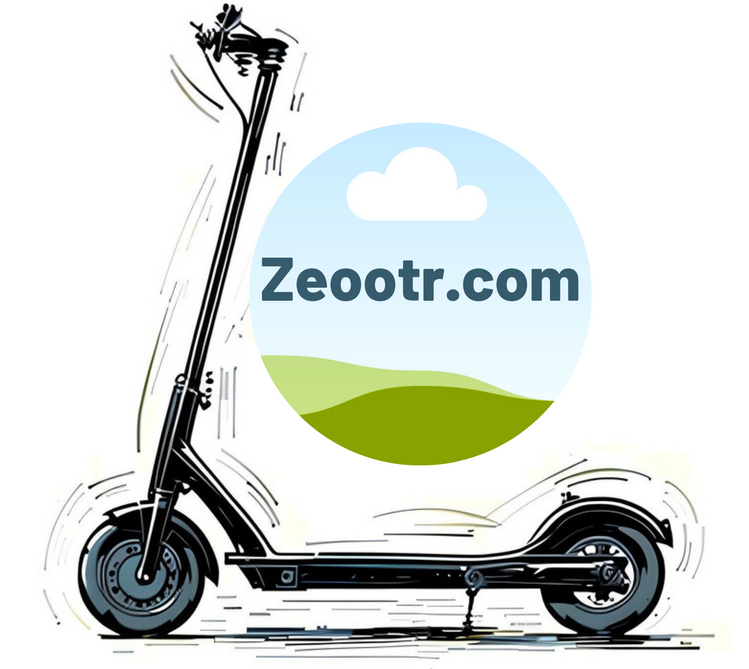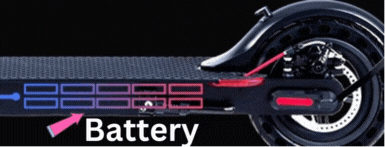

ELECTRIC KICK SCOOTER BATTERIES
The battery is the method of energy that drives your ekick scooter. Once you accelerate the thumb or hand grip throttle, the controller is engaged, and this in turn activates the battery to send energy to the hub motor placed inside the tire on your scooter, which gets the wheel moving. The battery itself, is usually located under the deck pedal(where you stand), and if the scooter has a removable battery it is either in the stem or under the deck pedal.
Besides being the scooter component that propels the scooter it is also the most expensive part of the scooter, and the most costly part to replace. Unfortunately, it will need to be replaced at some point, as all lithium-ion type batteries have a limited lifespan. You cannot recharge them forever. However, with proper care and maintenance, you can get the optimal lifespan from the battery.
Lithium-ion Battery
Electric kick scooters have lithium-ion batteries. These are the most used type of battery found on the majority of ekick scooters. Sealed lead acid batteries and nickel metal hydride were also used, but nowadays more manufacturers are opting for the lithium-ion based on their overall performance.There are several types of lithium-ion batteries on the market, and they are used according to the industry they are most favoured for based on their design and performance. For ekick scooters, the Lithium Nickel Manganese Cobalt Oxide battery is commonly chosen. Its' short name is NMC.
Features of the Lithium Nickel Manganese Cobalt Oxide (LiNiMnCoO2) include:
* they don't have issue with memory effect,
* they are low maintenance,
* higher voltage compared to other electric batteries,
* they have a slower discharge rate than other batteries,
* they have higher densities, thus they provide longer driving distances,
* optimal lifespan with efficient charging: they should not be fully discharged, around 20% of their capacity is recommended before charging,
* have capacities of 150wh - 750wh,
* their charging cycle lifespan is 500 - 1000 charges usually,
* battery life on average, is two to three years.
Charging Cycles - Lithium Batteries vs Lead Acid
Lithium batteries have the best charge cycles compared to the lead acid battery. 500 + charges is common, whereas the lead acid battery has a lower 300+ rating for charge cycles. This means that a lithium-ion battery can be charged 500 times before it begins to lose its' effectiveness to be able to sustain your scooter on a commute. Typically, the battery will have less optimal performance as it reaches and goes beyond its' rated charge cycles. Eventually, any charging will charge the battery, however, it will deplete at a accelerated rate, and not be able to provide enough energy to run your scooter. This is when you will need to replace the battery.C Rate
C rate is a method used to determine how your battery is discharged. It is a rating, and each type of battery is rated according to its overall capacity measured by its' volts, Wh, and Ah.So it would make sense that a smaller capacity battery would discharge quicker than a larger type battery. Most electric kick scooters have a C-rate of 0.5 to 2. A battery that has a C-rate of one would mean it can discharge its' rated capacity in one hour.
When shopping for your new ekick scooter or replacement battery, this is one way to determine the overall efficiency of the battery.
Battery - Volts, Wh, Ah
When looking at the specs of your new ekick scooter, you will see the Volts, Wh, and Ah. These are all useful to determine the capacity of the scooter as well as its' power, and its' longevity on commutes. The overall volts is the spec that shows the overall capable power of the scooter. So, a 48v would be greater than a 36v. These two volts are the most common on the low to mid priced ekick scooters. A 48v is good because it means your scooter can do things like climb steep hills with more ease, and go the distance without much effort. There is also the Wh(watt hours), common is 350wh - to 500wh, on mid range priced ekick scooters. Again, like volts, the large the number the more performance your going to get from the scooter. And, Ah(amp-hours), is the charging capacity of the scooter, common for this spec if 7Ah-10Ah or more. It stands for amp-hour, and is a loose measure of the battery capacity, and charging efficiency.If you don't know the voltage of your ekick scooter, you can use these metrics to calculate it. You divide the Watt hours(Wh) to the Amp-hours(Ah), so for example, if your Wh is 460, and your Ah is 10Ah, then your volts(voltage) would be 46v.
Also, specs usually show the rated power and the peak power of the scooter motor. The rated is the average energy it can expend while the peak power is the most power output you can get from the scooter.
The Perfect eKick Scooter Scenario - Specifications
Another thing to consider when shopping for a new ekick scooter is the reliability of the specs as shown. Most manufacturers of electric kick scooters will present their scooter specifications based on the optimal scooting experience. For that, it means: a flat surface, no hills, and an average body weight driving the scooter. What this means for the consumer, is that if we scoot up hills frequently or occasionally, and we weight over the average body weight, then the scooter is going to go a shorter distance than rated by the manufacturer.This is not necessarily a bad thing, it just means you have to take it into consideration, and conclude that a rated 30km range could now be 20 - 30% less than that, based on the conditions mentioned.
Battery Management System
Because all batteries are prone to overheat, overcharge, catch on fire, most manufacturers of ekick scooters now use an onboard battery management system - BMS.The BMS monitors the battery, and checks that it doesn't overcharge, discharge when it shouldn't, protects short circuits, and protects from excessive overheating. When listing a scooter's lithium battery specs, most manufacturers list the BMS system, and what conditions are covered. As safe as lithium-ion batteries are, things happen that can affect the conditon of the battery be it non intentional or accidental. With most BMS systems, the power will be cut when the battery reaches a preset voltage or Ah rating. This is good as it prevents damage to the battery, and it can still be used safely in the scooter.
Tips For Charging, Maintaining, Upgrading Your Battery
To get the best lifespan for your lithium-ion battery, follow the included tips with your new kick scooter brochure. Generally speaking, all lithium-ion batteries follow these guidelines:Use the included charging cable and plug it into the wall outlet first (standard wall outlet is ok), then plug the charge end into the charging port on your ekick scooter battery. If you battery is removable, then follow the steps as outlined in your manufacturers brouchure to remove it before charging it. Charge the battery only for the time it needs to fully charge it. Usually it is red while charging and green once charged, but this depends on each manufacturer, as they may differ somewhat. Don't overcharge the battery, as this can diminish its longevity over time.
Cool - Then Ride
If you just finished riding your scooter, wait 40 mins before you start charging it, so it can cool somewhat. Likewise, once the charging is completed, wait before going for a ride, so it can cool somwhat from the charging. Don't leave the scooter in extreme cold or hot locations for any length of time.
Keep The Battery Compartment Dry
The battery is securely enclosed in a compartment on the deck, however, certain environmental conditions can cause problems with the battery. For instance, if you decide to go riding in a rain storm, the battery could sustain damage, even a bit of water can cause havoc. Each ekick scooter is rated for rainy weather and puddles with an ip rating, but very few are rated for extreme exposure to inclimate weather. Typically, ip rating of 4 can withstand light rain, whereas, an ip rating of 5 you can scoot thru light puddles, and a rating of 65, you can scoot yourself thru big puddles.
Voltage and Charge - Keep The Same
If you use a different charger, than the original charger, make sure it is the same voltage(V) and charge(Ah). Charge your scooter at no less than 20% capacity, this will prolong its' lifespan also. Don't let it discharge to 0, as this can wear the battery and lessen its' life.
Upgrading To A New Battery
When upgrading your battery, there are certain dos and don'ts to follow. Do buy a battery with the same volts and watt hours(Wh) as your original battery, otherwise, you risk damaging your electrical system - controller. You can, however, buy a battery that has a higher amp-hour(Ah) rating than what you now have.
Upgrade Your Lead Acid Battery
Compared to lead acid batteries, lithium batteries can save space, charge faster, are lighter, and may give your scooter's speed a bit of a boost. And, they require less maintenance than the lead acid type. Your lead acid battery won't last nearly as long as the lithium-ion.
The capacity of lead-acid batteries is approximately 50% of the initial capacity after 1.5 years of use (about 400 cycles). With Li-ion batteries, it's about 75% of the initial capacity after 3 years of use (about 800 cycles).
Additionally, sealed lead-acid batteries include the possibility of lead contamination during the process of manufacturing and also disposal. Most manufacturers prefer Li-Ion batteries over sealed lead-acid batteries for electric kick scooters.
Future - Battery Models, Market Share
21700 vs 18650: Lithium-ion Battery Models
The two models currently on the market for lithium-ion are the 21700 and the 18650. The name supplies the battery measurements: Model 21700 is 21mm x 70mm, while the Model 18650 is 18mm x 65 mm length The newest model 21700, having volume which equals more energy, and also 10% lighter, which means less weight, which means more distance, more energy to use. Therefore, the benefit of going with 21700 vs 18650 means there’s more available energy because of the extra density. And, that means less cells have to be built to deliver the same energy, which could equal cheaper manufacturing.
Market Share
Lithium-ion leads the market share, because they offer performance and environmental benefits not available with either lead acid or nickel metal hydride type batteries. For the future, it is predicted that the Lithium-ion battery will be the traditional battery technology used for electric kick scooters.
Lithium-ion - NMC
Analysts for the battery industry estimate that the NMC battery type will prevail with 20% of all lithium-ion battery cells on the market by the year 2025. And, big name battery makers like: BYD, LG, Murata, Panasonic, Samsung, all prefer the NMC battery, including for EVs.
Homepage